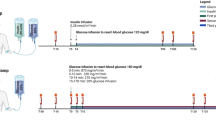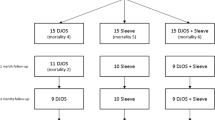The Roux-en-Y gastric bypass (RYGBP) and the biliopancreatic diversion (BPD) induce long-term control of type 2 diabetes in morbidly obese individuals. The reasons for such an effect on glycemic metabolism are thought to be secondary to reduced food intake, weight loss and modifications of the enteroinsular axis which is impaired in type 2 diabetic patients. Both GLP-1 and GIP have an impaired secretin effect in type 2 diabetics, and surgery can restore this function. GIP is a peptide secreted by the duodenal K-cells in response to ingested fat and carbohydrate. In obese type 2 diabetes patients, its receptor on β-cells is down-regulated. GLP-1 is a peptide secreted by the gut L-cells, and, in type 2 diabetes, its secretion is impaired. Both RYGBP and BPD provide durable GLP-1 delivery, both during fasting and after meal ingestion, inducing L-cell stimulation by early arrival of nutrients in the distal ileum. The secretion of GLP-1 influences glucose metabolism by inhibiting glucagon secretion, stimulating insulin secretion, delaying gastric emptying and stimulating glycogenogenesis. In conclusion, the early arrival of a meal in the terminal ileum seems to be the common feature of both operations that leads to an improvement in glycemic metabolism and to resolution of type 2 diabetes.
Similar content being viewed by others
Author information
Authors and Affiliations
Rights and permissions
About this article
Cite this article
Patriti, A., Facchiano, E., Sanna, A. et al. The Enteroinsular Axis and the Recovery from Type 2 Diabetes after Bariatric Surgery. OBES SURG 14, 840–848 (2004). https://doi.org/10.1381/0960892041590818
Published:
Issue Date:
DOI: https://doi.org/10.1381/0960892041590818




